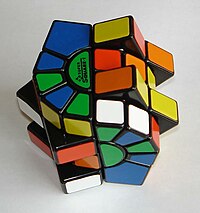Rubik's? that's too common, now i wanna try making this

into this

for y'all rubik's lovers (that's new to this challenge) the notation will be completely different. i'll show rotations (like all the guides) using a... pair (a, b) which means
- rotate the U layer a × 30° clockwise, and if the a value is negative, do it counter-clockwise.
- rotate the D layer b × 30° clockwise, and if the b value is negative, do it counter-clockwise. (relative to that side! do it while facing the side to clear confusion)
- twist the right hand side of the puzzle 180°

the red face will be the F side, green U side, etc.
so make sure to begin all the sequences with the line on the circle facing a bit more (not less) than 6/12 o'clock position.
First Step
return the "cube" to a cube form. i don't know any algorithm for this, i do it instinctively. anyway algorithm complicates this, i only know 3 algorithms and that's enough for me :x
basically, concentrate on one of the layer pairs, so either the outer layers or the inner layers. after you finish one of the pairs, when you solve the other pair, rather than aligning the finished layers as if in a cube form, twist one of the layer 30° any way possible. this will preserve square shape in both layers.
Second Step
now it is in a cube form, try to correct the corners position so they are in the correct layer, not necessarily in the correct position. for the middle layers, it's a bit hard, that sometimes the same color corners get redundant in one layer. the idea is to solve one layer's corners, as the other will follow.
Third Step
if you still have some edges not on the correct layer, now algorithms get in the show.
(1,0), (0,-3), (0,-3), (-1,-1), (1,4), (0,3)
it will swap edges UR (layer U edge R) and BR (relative to top layer).
Fourth Step
after all the corners and edges in the right layer and making sure the inner circles are correct, let's start making the cube pleasing to the eyes. to swap corners UFR (layer U, corner FR) and UBR, use this
(1,0), (3,0), (0,-3), (3,0), (-3,0), (-3,3)
if the opposite colors of the inner layer are swapped but the other are in the correct position, look to extra step.
note that this corners swap algo changes the parity condition (either you have or not) however this is not possible in the outer layers as you have the inner circle, so you can count how many edges swap and corners swap you need to solve the cube, add them together and if they're odd, you will have parity and if they're even, you won't have parity problems. (actually i'm not really sure of this. these 6 days i've been playing the super sq-1 shows that it is true.)
Fifth Step
now we will have edge swaps in the same layer. this one algorithm will swap you the edge UR with UB AND edge DR and DB (this is not a 4-cycle algorithm).
(0,2), (0,-3), (1,1), (-1,2)
as i said previously, you may have parity problem, in which only two edges remain to be swapped. you can use the parity fixing algorithm here (which will make the cube not cube for a moment [doh])
(3,0), (3,0), (1,2), (-2,3), (-2,3), (-2,5), (4,0), (0,1), (3,5)
(-3,0), (2,3), (-2,4)
or if somehow, like me, your cube is defected such that you can't make a vertical turn on these shapes (that line that crosses through 3 corners)
 ,
,  ,
, 
due to the corners being a bit larger than 60° (it is supposed to be π/3 rads y'know!), then just use the edge swapping algorithm (Step 3) and swap the same colored edges, as for me, it always happened in the inner layers and doesn't matter at all. it fixes the parity by swapping 2 opposite edges, alongside with swapping 2 edges across layers.
now if you've just finished one pair of layers, go finish the other pair! (don't forget to twist one of the finished layer 30° before any algorithms!)
Extra Step
if in the middle of the fourth step, you see that somehow, the opposite colors of the inner layer are swapped but the other are in the correct position, you can either do it intuitively or for those who are lazy,
(1,0), (6,6)
that's it.
btw 6 means half turn, which means 180° turn which also means π radians! (oh well)
Allright, hopefully it covered all i need to cover. the algorithm is from here (except the extra step) and the images are from here and here. thanks to whoever wrote the first article and Lars Vandenbergh! i think of this method i'm using similar to the Rubik's beginner method and Lars' method is akin to Fridrich's method. by the way my super sq-1 always has 4 corners and 4 edges in each layer, due to the defect i mentioned earlier which makes it easier.
-EOBP- end of blog post this is!
wrote it in full english for the sake of internationalism lol


No comments:
Post a Comment
leaving a comment encouraged, leaving without commenting discouraged